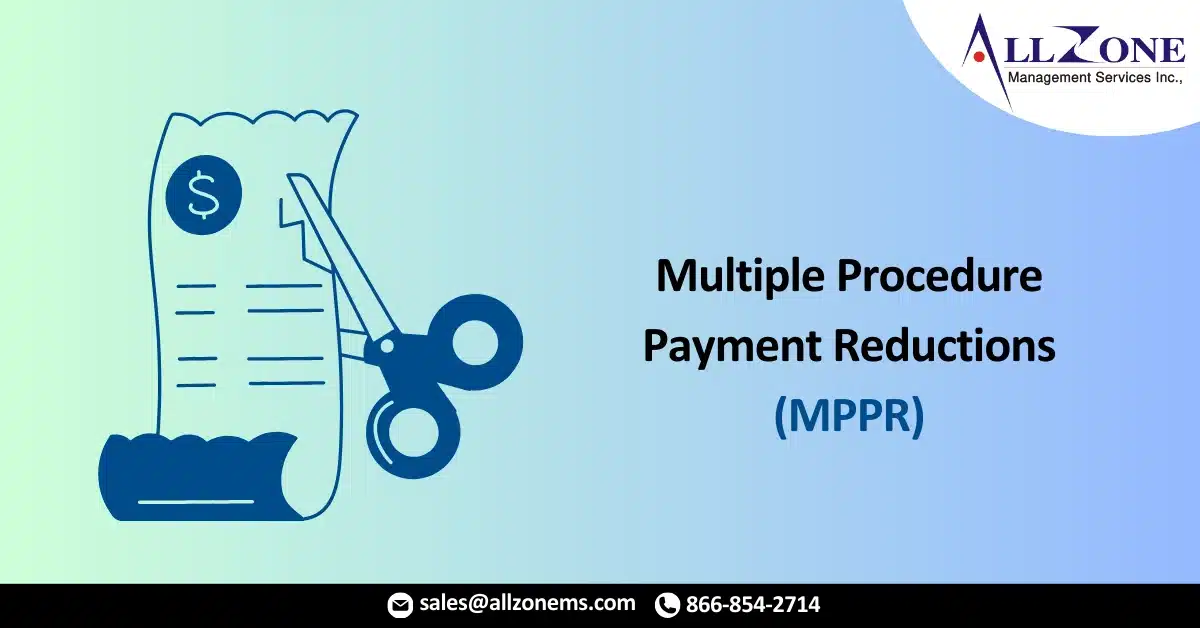The multiple procedure payment reduction (MPPR) means that if a healthcare provider performs multiple procedures during a single patient encounter, Medicare (and many commercial insurers) typically will pay “full price” for only the highest-valued procedure.
The reason is explained in Chapter 1 of the National Correct Coding Initiative (NCCI) Policy Manual:
Most medical and surgical procedures include pre-procedure, intra-procedure, and post-procedure work. When multiple procedures are performed at the same patient encounter, there is often overlap of the pre-procedure and post-procedure work. Payment methodologies for surgical procedures account for the overlap of the pre-procedure and post-procedure work.
How MPPR Affects Payment:
Under MPPR rules, Medicare pays less for the second and subsequent procedures performed during the same patient encounter. Reductions may be calculated in several ways, depending on the services/procedures involved.
Most typically, the primary (highest valued) procedure will be reimbursed at 100 percent of the fee schedule value, and the second and all subsequent procedures will be reimbursed at 50 percent of the fee schedule value. When multiple endoscopic procedures within the same code family are reported, the “base” value of the endoscopy is paid only one time. Learn more, here. Special rules also apply for certain diagnostic imaging procedures, therapy services, diagnostic cardiovascular services, and diagnostic ophthalmology services.
MPPR Rules Apply Only to Same Provider/Group:
Note that MPPRs apply only if the same provider, or providers within the same group practice, are reporting procedures/services for the same patient, on the same day.
Chapter 12 of the Medicare Carriers Manual, Section 40.6 – Claims for Multiple Surgeries states:
Multiple surgeries are separate procedures performed by a single physician or physicians in the same group practice on the same patient at the same operative session or on the same day for which separate payment may be allowed. Co-surgeons, surgical teams, or assistants-at-surgery may participate in performing multiple surgeries on the same patient on the same day.…
There may be instances in which two or more physicians each perform distinctly different, unrelated surgeries on the same patient on the same day (e.g., in some multiple trauma cases). When this occurs, the payment adjustment rules for multiple surgeries may not be appropriate. In such cases, the physician does not use modifier “-51” unless one of the surgeons individually performs multiple surgeries.
Individual insurers define multiple procedures in similar language, stressing that they apply only when the same physician, or physicians within the same group, report services/procedures for the same patient on the same day.
For example, United Healthcare defines multiple procedures as, “When multiple procedures are performed on the same day, by the Same Group Physician and/or Other Health Care Professional.” In these circumstances, “reduction in reimbursement for secondary and subsequent procedures will occur. Payment at 100% for secondary and subsequent procedures would represent reimbursement for duplicative components of the primary procedure.”
BlueCross/BlueShield of North Carolina adopts nearly identical language, stating, “When multiple surgeries or procedures are performed by a single physician or physicians in the same group practice on the same patient at the same operative session, reduction in reimbursement for secondary and subsequent procedures may occur.”
MPPR Doesn’t Apply to All Codes:
Note also that MPPR rules do not apply to every CPT® code. Excluded services/procedures include:
Significant, separately identifiable E/M services provided on the same day as other procedures/services and properly appended with modifier 25 Significant, separately identifiable evaluation and management service by the same physician or other qualified health care professional on the same day of the procedure or other service
Any designated “add-on” CPT® code (listed with a “+” next to the descriptor)
Any procedure designated by CPT® as “Modifier 51 exempt,” which may be identified in the CPT® codebook by a “circle with a slash” next to the code.
You can find a full list of “add-on” and “modifier 51” exempt procedures in Appendices D and E of the CPT® codebook. The relative values assigned to these codes factor in the “additional” nature of the procedure/services; therefore, there is no justification to reduce reimbursement when these codes are reported in addition to other procedures.
For more information: CLICK HERE

